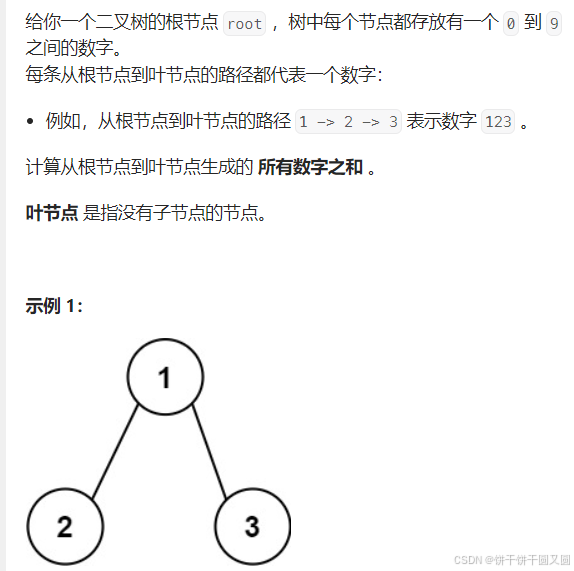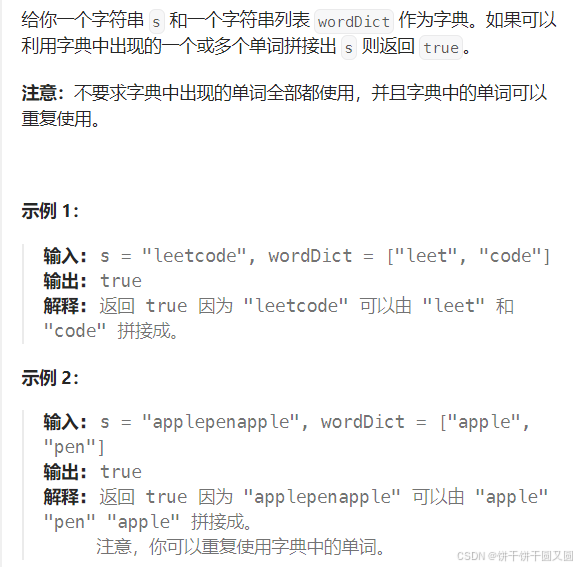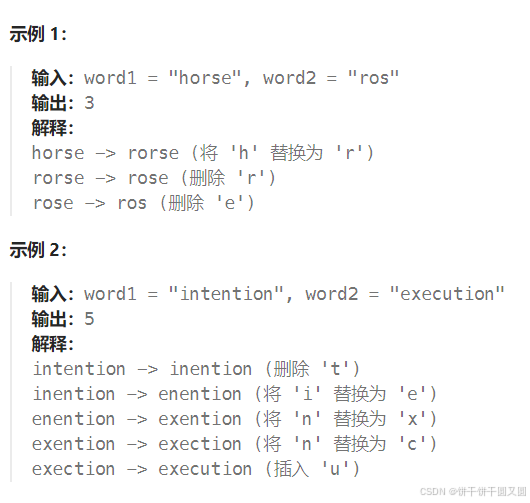两数之和

暴力枚举
cpp
class Solution {
public:
vector<int> twoSum(vector<int>& nums, int target) {
int n = nums.size();
for(int i=0; i<n-1; i++){
for(int j=i+1; j<n; j++){
if(nums[i] + nums[j] == target){
return {i,j};
}
}
}
return {0,0};
}
};哈希表
暴力枚举的时间复杂度高的原因是寻找target-x的时间复杂度过高。
cpp
class Solution {
public:
vector<int> twoSum(vector<int>& nums, int target) {
unordered_map<int, int> map1; //<num, index>
int n = nums.size();
for(int i=0; i<n; i++){
if(map1.count(target-nums[i])){
return {map1[target-nums[i]], i};
}else{
map1[nums[i]] = i;
}
}
return {0,0};
}
};三数之和
cpp
class Solution {
public:
vector<vector<int>> threeSum(vector<int>& nums) {
vector<vector<int>> res;
sort(nums.begin(),nums.end());
int n = nums.size();
for(int i=0; i<n-2; i++){
if(i!=0 && nums[i]==nums[i-1]){
continue;
}
int j = i+1;
int k = nums.size()-1;
while(j < k){
if(nums[i]+nums[j]+nums[k] == 0){
res.push_back({nums[i],nums[j],nums[k]});
do{
j++;
k--;
}while(j<k && nums[j]==nums[j-1] && nums[k]==nums[k+1]);
}else if(nums[i]+nums[j]+nums[k] < 0){
j++;
}else{
k--;
}
}
}
return res;
}
};二叉树的最近公共祖先

存储父节点
可以用哈希表存储所有节点的父节点,然后从p节点依次向上跳,将经过的地方标记为true。q节点向上跳,遇到的第一个为true的节点,就是公共节点。
cpp
/**
* Definition for a binary tree node.
* struct TreeNode {
* int val;
* TreeNode *left;
* TreeNode *right;
* TreeNode(int x) : val(x), left(NULL), right(NULL) {}
* };
*/
class Solution {
public:
unordered_map<int, TreeNode*> father;
unordered_map<int, bool> visited;
void createFather(TreeNode* root){
if(root->left){
father[root->left->val] = root;
createFather(root->left);
}
if(root->right){
father[root->right->val] = root;
createFather(root->right);
}
}
TreeNode* lowestCommonAncestor(TreeNode* root, TreeNode* p, TreeNode* q) {
father[root->val] = nullptr;
createFather(root);
while(p){
visited[p->val] = true;
p = father[p->val];
}
while(q){
if(visited[q->val]){
return q;
}
q = father[q->val];
}
return nullptr;
}
};求根节点到叶节点数字之和

cpp
/**
* Definition for a binary tree node.
* struct TreeNode {
* int val;
* TreeNode *left;
* TreeNode *right;
* TreeNode() : val(0), left(nullptr), right(nullptr) {}
* TreeNode(int x) : val(x), left(nullptr), right(nullptr) {}
* TreeNode(int x, TreeNode *left, TreeNode *right) : val(x), left(left), right(right) {}
* };
*/
class Solution {
public:
void dfs(TreeNode* root, vector<int>& nums, int sum){
if(root->left == nullptr && root->right == nullptr){
nums.push_back(sum*10 + root->val);
return;
}
sum = (sum * 10) + root->val;
if(root->left){
dfs(root->left, nums, sum);
}
if(root->right){
dfs(root->right, nums, sum);
}
}
int sumNumbers(TreeNode* root) {
vector<int> nums;
dfs(root, nums, 0);
int sum = 0;
for(int num: nums){
sum += num;
}
return sum;
}
};二叉树展开为链表
cpp
/**
* Definition for a binary tree node.
* struct TreeNode {
* int val;
* TreeNode *left;
* TreeNode *right;
* TreeNode() : val(0), left(nullptr), right(nullptr) {}
* TreeNode(int x) : val(x), left(nullptr), right(nullptr) {}
* TreeNode(int x, TreeNode *left, TreeNode *right) : val(x), left(left),
* right(right) {}
* };
*/
class Solution {
public:
void inorder(TreeNode* root, vector<TreeNode*>& nums) {
if (root != nullptr) {
nums.push_back(root);
inorder(root->left, nums);
inorder(root->right, nums);
}
}
void flatten(TreeNode* root) {
if(root == nullptr){
return;
}
vector<TreeNode*> nums;
inorder(root, nums);
TreeNode* p = root;
p->left = nullptr;
for (int i = 1; i < nums.size(); i++) {
nums[i]->left = nullptr;
nums[i]->right = nullptr;
p->right = nums[i];
p = nums[i];
}
}
};爬楼梯
cpp
class Solution {
public:
int climbStairs(int n) {
if(n <= 2){
return n;
}
int p = 1, q = 2;
for(int i=3; i<=n; i++){
int sum = p+q;
p = q;
q = sum;
}
return q;
}
};打家劫舍

动态规划
如果只有一间房屋,则偷窃该房屋获得最高金额。
如果有两件,选择其中最高的一间,获得最高金额。
如果房间数量大于2,对于第k间房屋:
- 偷窃第k间房,偷窃总金额为前k-1的最高总金额加上第k间房。
- 不偷窃第k间房,偷窃总金额为前k-1的最高总金额。
cpp
class Solution {
public:
int rob(vector<int>& nums) {
int n = nums.size();
if(n == 1){
return nums[0];
}
if(n == 2){
return max(nums[0], nums[1]);
}
vector<int> dp(n, 0); //dp[i]偷到第i个房间的最高金额
dp[0] = nums[0];
dp[1] = max(nums[0], nums[1]);
for(int i=2; i<n; i++){
dp[i] = max(dp[i-1], dp[i-2] + nums[i]);
}
return dp[n-1];
}
};单词拆分

定义dp[i]表示0,...,i-1是否能被空格拆分成若干字典中出现的单词。
cpp
class Solution {
public:
bool wordBreak(string s, vector<string>& wordDict) {
unordered_set<string> set1;
for(string word : wordDict){
set1.insert(word);
}
int n = s.size();
vector<int> dp(n+1);
dp[0] = true;
for(int i=1; i<=n; i++){
for(int j=0; j<i; j++){
if(dp[j] && set1.find(s.substr(j, i-j)) != set1.end()){
dp[i] = true;
break;
}
}
}
return dp[n];
}
};最长递增子序列
cpp
class Solution {
public:
int lengthOfLIS(vector<int>& nums) {
int n = nums.size();
vector<int> dp(n, 0); //dp[i]为0,...,i最长序列,且nums[i]被选取
dp[0] = 1;
for(int i=1; i<=n-1; i++){
dp[i] = 1;
for(int j=0; j<i; j++){
if(nums[i] > nums[j]){
dp[i] = max(dp[i], dp[j]+1);
}else if(nums[i] == nums[j]){
dp[i] = max(dp[i], dp[j]);
}
}
}
return *max_element(dp.begin(), dp.end());
}
};最小路径和
cpp
class Solution {
public:
int minPathSum(vector<vector<int>>& grid) {
int m = grid.size(), n = grid[0].size();
vector<vector<int>> dp(m, vector<int>(n, 0));
dp[0][0] = grid[0][0];
for(int i=0; i<m; i++){
for(int j=0; j<n; j++){
if(i == 0 && j == 0){
continue;
}
if(i == 0){
dp[i][j] = dp[i][j-1] + grid[i][j];
}else if(j == 0){
dp[i][j] = dp[i-1][j] + grid[i][j];
}else{
dp[i][j] = min(dp[i][j-1], dp[i-1][j]) + grid[i][j];
}
}
}
return dp[m-1][n-1];
}
};不同路径二

cpp
class Solution {
public:
int uniquePathsWithObstacles(vector<vector<int>>& obstacleGrid) {
int m = obstacleGrid.size(), n = obstacleGrid[0].size();
vector<vector<int>> dp(m, vector<int>(n, 0));
if(obstacleGrid[0][0] == 1){
return 0;
}
dp[0][0] = 1;
for(int i=0; i<m; i++){
for(int j=0; j<n; j++){
if(i == 0 && j == 0){
continue;
}
if(obstacleGrid[i][j] == 1){
dp[i][j] = 0;
}else{
if((i == 0 && dp[i][j-1] != 0) || (j == 0 && dp[i-1][j] != 0)){
dp[i][j] = 1;
}else if(i == 0 || j == 0){
dp[i][j] = 0;
}else{
if(dp[i-1][j] != 0){
dp[i][j] += dp[i-1][j];
}
if(dp[i][j-1] != 0){
dp[i][j] += dp[i][j-1];
}
}
}
}
}
return dp[m-1][n-1];
}
};编辑距离
给两个单词word1和word2,请返回将word1转换成word2所使用的最少操作数。

cpp
class Solution {
public:
int minDistance(string word1, string word2) {
int m = word1.size(), n = word2.size();
if(n * m == 0){
return n+m;
}
vector<vector<int>> dp(m+1, vector<int>(n+1)); //dp[i][j] 以i-1替换成j-1的最小操作次数
for(int i=0; i<=m; i++){
dp[i][0] = i; //删除i个变为空
}
for(int j=0; j<=n; j++){
dp[0][j] = j; //增加j个变为word2
}
for(int i=1; i<=m; i++){
for(int j=1; j<=n; j++){
if(word1[i-1] == word2[j-1]){
dp[i][j] = dp[i-1][j-1];
}else{
int del = dp[i-1][j] + 1;
int add = dp[i][j-1] + 1;
int rep = dp[i-1][j-1] + 1;
dp[i][j] = min(del, min(add, rep));
}
}
}
return dp[m][n];
}
};